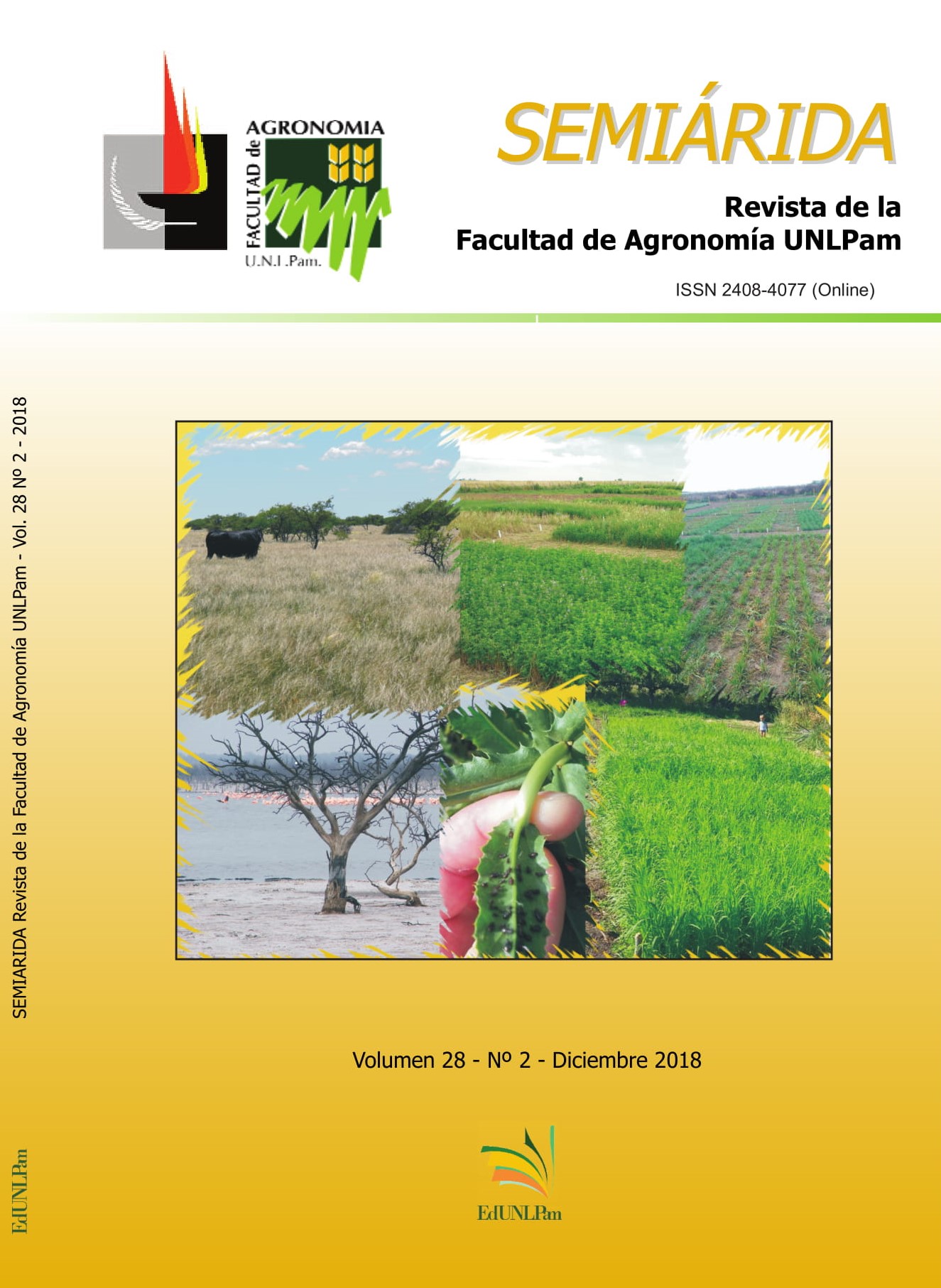Harmful and beneficial insects for safflower crop in the semiarid pampean region
Keywords:
Carthamus tinctorius L., aphids, true bugs, coccinellids, phenological state, natural enemiesAbstract
The work`s aims were to identify both harmful and helpful insect species for safflower crop and to study their distribution along time in relation to plant phenological state. The insect species identified as harmful were: Uroleucon jaceae L., Capitophorus elaeagni, Frankliniella occidentalis P., Dichelops furcatus (F.), Athaumasthus haematicus (Stål), Nezara viridula (L.), Nysius simulans Stål, Edessa meditabunda (F.), Piezodorus guildinii (W.), Helicoverpa zea B., Epicauta adspersa K., Spodoptera frugiperda (J. E. Smith), Chauliognathus scriptus (Germ.), Pantomorus auripes H. and Rachiplusia nu (G.). Regarding aphids, their highest density was observed at the beginning of November, when crop was in the state of branching, with invasion mainly of the upper third of plants: leaves, young shoots and flower heads. Among all harmful true bugs found in the crop, red bug Athaumastus haematicus (Stål)comprised the highest proportion and was detected before aphids attacks, when stem elongation of plants was just beginning. As for beneficial species, the six insects detected in sufflower crop were Hippodamia convergens G., Eriopis connexa G., Harmonia axyridis (P.), Nabis sp., Ophion sp. and Apis melifera L., besides various spider species. The coccinellidsHippodamia convergens; Eriopis connexa and Harmonia axydiris performed as the main natural control agents at crop.Downloads
References
Bernardos J. & M. Farrell. 2012. Evaluación de daño por paloma torcaza (Zenaida auriculata) en girasol y pérdida de cosecha en la Provincia de La Pampa campaña 2011-2012. INTA EEA Anguil, “Ing. Agr.Guillermo Covas”. 21 p.
Borror D.J., C.A. Triplehorn & N.F. Johnson. 1989. An introduction to the study of insects. Sixth Edition. Saunders College Publishing: 875 p.
Carpintero D. y A. Dughetti. 2012. Presencia de Dersagrena subfoveolata (Berg, 1892) (Hemíptera: Coreidae) en el cultivo de cártamo en el sur de la provincia de Buenos Aires. Revista de Investigaciones Agropecuarias (RIA). BioScriba 5(1): 36-42.
De Santis L. 1967. Catálogo de los himenópteros argentinos de la serie Parasítica, incluyendo Bethyloidea. Provincia de Buenos Aires Gobernación, Comisión de Investigación Científica, La Plata. 337p.
Dughetti A.C. & R. La Rosa. 2011. Estudio de los áfidos (Hemíptera: Aphididae) que atacan al cártamo (Carthamus tinctorius L.) y sus enemigos naturales en el sur de la provincia de Buenos Aires. Boletín Técnico N° 17. 26 p.
Dughetti A.C. & A.O. Zarate. 20102011.Resultados de la actividad con el cultivo de cártamo. Convenio oleaginosa moreno SA EEA INTA Hilario Ascasubi. 28 p.
Emongor V. 2010. Safflower (Carthamus tinctorius L.) the Underutilized and Neglected Crop: A Review. Departament of crop Sciencie and Production, Botswana College of Agriculture,Private Bag 0027, Gaborone, Botswana. Asian j. Plant Sci. 9(6): 299-306.
Frasier I.M. Lang. 2009. Informe de Campaña. Cártamo 2009. Secretaría de Agricultura, Ganadería, Pesca y Alimentación. Instituto Nacional de Tecnología Agropecuaria. Centro Regional La Pampa San Luis. 7 p.
Gauld I.D. 1980. An analysis of the classification of the Ophion genusgroup (Ichneumonidae). System. Entom. 5: 59-82.
Mündel H.H., R.E. Blackshaw, J.R. Byers, H.C. Huang, D.L. Johnson, R. Keon, J. Kubik, R. McKenzie, B. Otto, B. Roth & K. Stanford. 2004. Safflower Production on the Canadian Prairies. Agriculture and AgriFood Canada, Lethbridge Research Centre, Lethbridge, Alberta.
Muñoz B.S. 1977. Determinación del porcentaje de polinización natural en cártamo en el Valle del Yaqui, Son. En: Avances de la Investigación CIANO. OI 19761977 (M.F. Pacheco ed.). p. 1.
Rivas J. & R. Matarazzo. 2009. Producción de Cártamo, Consideraciones Generales. Boletín de divulgación N° 20. EEA INTA Hilario Ascasubi. 19 p.
Stehr F.W. 1987. Order Lepidoptera: 288596. En: Immature insects (F.W. Stehr ed.), Volume 1. Dubuque, Kendall/Hunt Publishing Company, 754p.
Stehr F.W. 1991. Immature Insects. Volume 2. Kendall / Hunt Publishing Company. 996 pp.
Wharton R.A., P.M. Marsh & M.J. Sharkey. 1997. Manual of the new world genera of the family Braconidae (Hymenoptera). The International Society of Hymenopterists. Washington, DC. 439 p.
Downloads
Published
Issue
Section
License
La Editorial de la Universidad Nacional de La Pampa (EdUNLPam) exigirá a los/as autores/as la firma del siguiente documento:
La EdUNLPam lleva a cabo la publicación del artículo: (Título del Artículo) en SEMIÁRIDA Rev.Fac.Agron UNLPam ISSN 2362-4337 (impresa) ISSN 2408-4077 (en línea), del cual el/los abajo firmantes son autores de una o más partes. En el mismo acto, el/los autores entregan exclusivamente a la EdUNLPam todos sus derechos protegidos por las leyes de propiedad intelectual que rigen en la Argentina para reproducir, publicar, editar, fijar, comunicar y transmitir públicamente en cualquier formato o medio impreso o electrónico, inclusive internet, el artículo enviado a publicación e incluirlo en índices o bases de datos nacionales e internacionales. A cambio, la EdUNLPam entrega a los autores la autorización para la publicación o reimpresión con ines académicos y educativos en cualquier libro o medio de divulgación, con la sola obligación de citar el artículo original publicado en la EdUNLPam. Cada autor acuerda en que el material provisto a la EdUNLPam es un trabajo original, que no ha sido impreso o publicado en cualquier otro medio con anterioridad y que no vulnera derechos de terceros. El Primer autor tendrá la posibilidad de leer y corregir el artículo ya editado como “prueba de galera”, pero si el autor no devolviera esas correcciones de la prueba de galera dentro del tiempo especificado, el proceso de producción y publicación podrá proseguir sin la aprobación del autor. El/los autor/es no recibirán compensación monetaria de la EdUNLPam por el uso del material contenido en este artículo y asumen la responsabilidad de las opiniones vertidas en él.






.png)



22.png)



.jpg)




.jpg)
